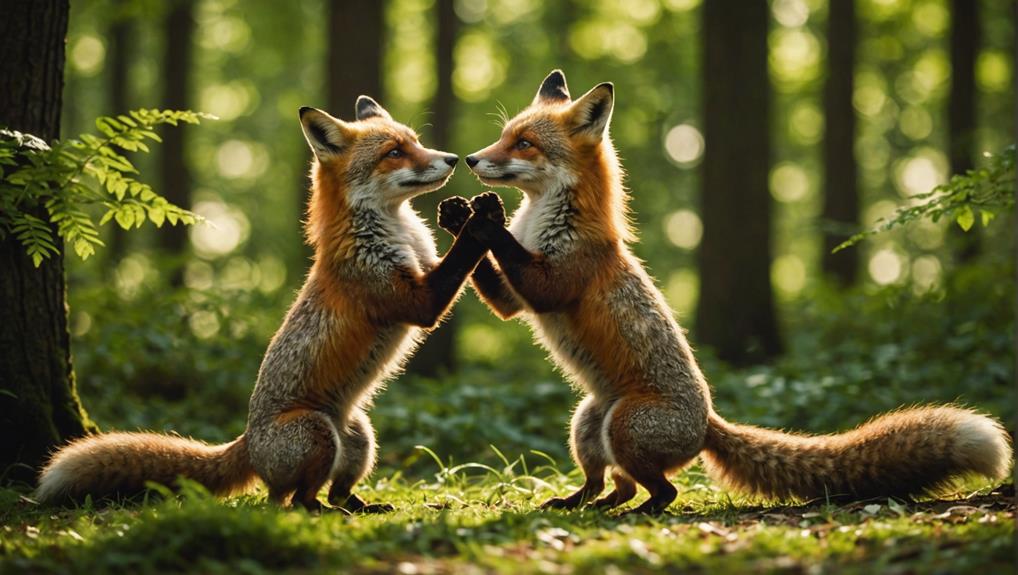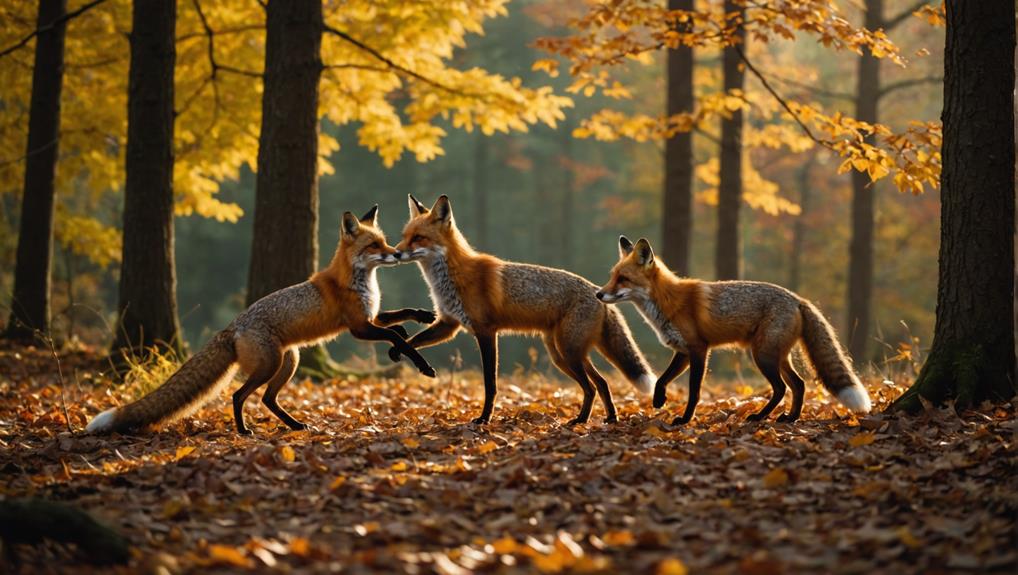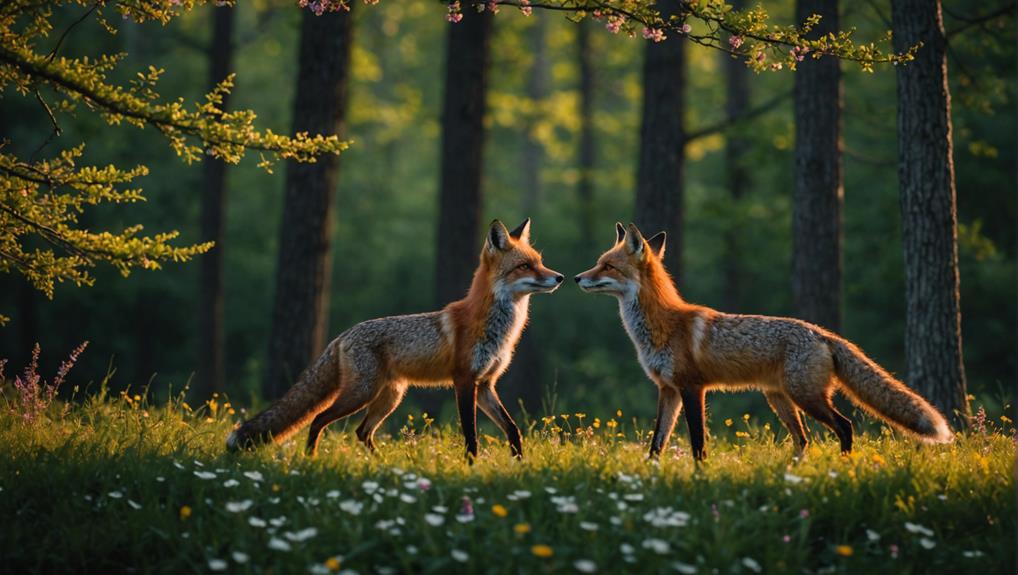Foxes have some truly unique mating rituals that are a mix of charm and competition! During mating season, males show off by barking and scent-marking their territory, hoping to impress a vixen. Once the magic happens, they engage in a copulatory lock that can last up to 30 minutes, ensuring the best chance of fertilization. Notably, many urban foxes have litters with multiple dads, boosting genetic diversity. So, while it may seem like a love story, it's also a fierce competition for those prime mating spots. Keep that curiosity alive, and you'll uncover even more about their enchanting lives!
Contents
Mating Season Overview
When a male successfully catches a vixen's eye, the magic of copulation occurs. This can last anywhere from 15 to 30 minutes and might even involve a copulatory lock.
This interesting phenomenon helps guarantee a higher chance of fertilization—talk about commitment!
Once the mating is done, the gestation period begins, averaging about 53 days.
If all goes well, you can expect four to five adorable cubs to arrive, bringing joy and chaos to the den.
Courtship Behaviors
When it comes to courtship, male foxes really know how to put on a show!
They'll follow a female closely, barking and screaming to get her attention while competing with other males for her favor.
It's like a wild dance party in the woods, where scent-marking becomes their way of saying, "Hey, I'm ready for love!"
Vocalizations and Scent Marking
During the mating season, vocalizations and scent marking play essential roles in the courtship behaviors of foxes. Vixens and dog foxes use these methods to communicate their readiness and establish their presence. While vixens emit high-pitched screams, males bark to attract mates. It's like a wild concert out there, with each fox trying to outdo the other!
Scent marking becomes important as both sexes urine mark to announce their reproductive status and territory. This helps them navigate the social scene, especially during the vixen's short estrous cycle, lasting only one to six days.
Here's a quick look at how vocalizations and scent marking work in this unique courtship:
| Behavior | Purpose |
|---|---|
| Vocalizations | Attract mates and establish presence |
| Scent Marking | Communicate reproductive status |
| Competitive Displays | Help dominant dog foxes secure mates |
| Identify Estrous Females | Increase mating opportunities |
Male Competition Dynamics
Engaging in fierce competition, male foxes showcase a variety of courtship behaviors to win the favor of a receptive female vixen. During mating season, you'll witness multiple males vying for her attention, enthusiastic to impress with their displays of strength and persistence. The dominant males often have an advantage, boasting higher copulation rates than their smaller competitors. It's all about that confident swagger!
As the vixen enters her estrous period, lasting anywhere from 1 to 6 days, the males stay close, following and guarding her. This dedication is essential, as they need to prove they're the best choice for her. Notably, competition is less about territorial battles and more about wooing the vixen.
These charming foxes are focused on impressing her rather than squabbling over land. Female selection plays a significant role in this dance of love. Males must adapt their strategies, showing off their vigor while paying attention to the vixen's preferences.
Copulatory Mechanisms

Foxes exhibit fascinating copulatory mechanisms that enhance their reproductive success and safety. One key feature is the copulatory tie, which occurs when the male's bulbus glandis engorges, locking him and the vixen together. This tie can last from a few minutes to over 30 minutes, providing mutual protection during vulnerable moments.
Here's a quick look at some important aspects:
| Mechanism | Description |
|---|---|
| Copulatory Tie | Locks mating pair together for safety. |
| Bulbus Glandis | Engorges to create the tie. |
| Vixens' Copulatory Plug | Prevents extra-pair matings after successful copulation. |
| Mating Attempts | Multiple tries increase chances of fertilization. |
| Injury Risks | Separation can lead to injuries like paraphimosis. |
This locking mechanism not only enhances the likelihood of successful copulation, but it also serves as an anti-predator strategy. It's fascinating how nature works! After mating, vixens produce copulatory plugs, a unique way to guarantee their mate's genetic contribution. So, while these red foxes may seem crafty, they've got a method to their madness that keeps them safe and sound.
Genetic Diversity in Mating
When you think about foxes, you might picture a loyal pair, but it turns out their love lives are a bit more complicated.
Many urban foxes are mixing things up by having litters with multiple dads, which helps keep their genetics fresh and lively. This behavior not only promotes genetic diversity in fox populations but also enhances their adaptability to varying environmental conditions.
Plus, depending on food availability, these clever creatures may switch between dating a bunch of partners or sticking to one, showing just how adaptable they really are!
Polyandry and Paternity Variation
Revealing a fascinating aspect of fox behavior, recent studies show that about one-third of red fox litters feature multiple fathers, indicating a notable trend toward polyandry. This practice not only spices up their mating systems but also enhances genetic diversity among their pups. The dynamics of paternity in foxes are complex and intriguing!
| Mating Strategy | Description | Impact on Genetic Diversity |
|---|---|---|
| Polyandry | Multiple males mating with one female | Increases genetic variation |
| Monogamy | One male and one female pair | Limited genetic diversity |
| Subordinate Males | Lower status males copulating | Reduced reproductive success |
| Dominant Males | Higher status males with more success | Greater genetic influence |
In these social groups, dominant females often mate outside their pack, showing that a little variety can be beneficial. While monogamous pairings occur in about 50% of breeding attempts, it's clear that foxes have unique reproductive strategies. So, the next time you see a litter of fox pups, remember, they might have a diverse family tree, thanks to their playful approach to paternity!
Environmental Influence on Mating
Many factors in their environment can greatly influence fox mating behaviors, particularly impacting genetic diversity. For instance, urban foxes often find themselves in resource-rich habitats, where food is plentiful. This abundance encourages extra-pair matings, leading to some interesting family trees. Imagine discovering that a third of urban fox litters might've multiple fathers! It definitely challenges the traditional view of monogamous mating systems.
Urban foxes, with their strong social structures and adaptable nature, are adept at maneuvering these mating dynamics. Urban habitats support survival by providing ample food sources, which further enhances their reproductive strategies.
Dominant females, always looking to enhance genetic diversity, often mate outside their social groups. This clever strategy helps guarantee healthy cubs and a robust population. When food is scarce, monogamous breeding patterns become more common, as foxes stick to what they know. But in thriving environments, polygyny reigns supreme.
Population density also plays a role. In areas with more foxes, you'll find diverse mating behaviors, all aimed at keeping genetic variability alive.
Environmental Influences on Rituals

Environmental factors play an essential role in shaping the mating rituals of foxes. Whether you're observing red foxes in a bustling city or in a quiet rural area, the environment can greatly affect their unique mating rituals.
For instance, food availability often dictates how these charming creatures approach their breeding season. In diverse habitats, such as forests and urban areas, habitat diversity influences fox behavior and mating strategies.
Here are a few key influences:
- Resource-Rich Habitats: In areas with plenty of food, urban and rural foxes tend to engage in more extra-pair matings, which can result in a varied genetic pool.
- Food Shortages: When resources dwindle, like during harsh weather, foxes lean towards monogamy, focusing on their primary mate to maximize the chances of survival.
- Population Density: Higher numbers of foxes can complicate courtship, leading to more complex mating dynamics, so you might see some interesting behaviors!
- Seasonal Changes: Timing is everything! Northern foxes enter estrus later than their southern buddies due to temperature and food availability.
Social Structures and Mating Dynamics
Understanding the social dynamics of foxes adds another layer to their mating rituals.
You'll find that red foxes often form monogamous pairs, sharing their territory, but sometimes, these partnerships don't last forever. In a unique twist, subordinate males sometimes help the dominant breeding pair raise their cubs, creating a sense of teamwork within family groups. Isn't that sweet?
In urban environments, these social structures can be influenced by resource availability, as foxes adapt to human presence and exploit various food sources, which can shift the dynamics of their relationships and mating strategies resource sharing among foxes.
When it comes to mating, male foxes face fierce competition for the attention of females. The dominant dog foxes usually get the most action, thanks to their better control over territory. You could say they've got the best "real estate" in the fox world!
Environmental factors also play a role; food availability can shift social structures and mating strategies, making fidelity a bit of a wild card.
During the breeding season, foxes communicate through vocalizations and scent marking, which helps them find mates and establish territory. Imagine a bustling social scene where every call and smell sends a message!
All these interactions are part of the intricate dance of fox life, blending competition, cooperation, and a bit of charm in their quest for love.
Frequently Asked Questions
What Are the Mating Practices of Foxes?
Foxes demonstrate fascinating mating practices through courtship behaviors, vocal mating calls, and careful den selection. They mark territory to attract mates, showcasing their reproductive anatomy during seasonal breeding, ultimately ensuring strong parental care for their offspring.
Why Do Female Foxes Scream During Mating?
You might wonder why female foxes scream during mating. These vocalizations, key to mating communication, signal receptivity, assert dominance, and influence partner selection, shaping their social dynamics and reproductive behavior throughout the intense mating season.
What Are the Breeding Patterns of Foxes?
During the breeding season, you'll observe foxes displaying courtship behaviors and territory marking. They choose dens carefully, balancing mate fidelity with breeding success, ultimately ensuring the best conditions for offspring rearing and survival.
Why Are 2 Foxes Stuck Together?
You might wonder why two foxes are stuck together. Their mating bonds deepen through this intriguing behavior, driven by reproductive instincts. During this moment, they guarantee successful courtship displays and enhance kit rearing opportunities for the future.
Final Thoughts
So, next time you think about romance, don't forget the foxes! Their unique mating rituals remind us that love can be as wild as it is sweet. Who knew that while we're swiping right on dating apps, these clever critters are busy showcasing their charm in the woods? In the end, whether it's a fancy dinner or a playful chase, love is all around us—just with a bit more fur and a lot less awkward small talk!














